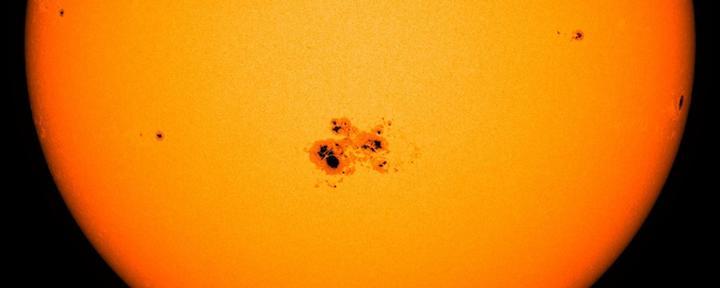13.06.2019

Researchers at CU Boulder have discovered hints that humanity’s favorite star may have a dual personality, with intriguing discrepancies in its magnetic fields that could hold clues to the sun’s own “internal clock.”
Physicists Loren Matilsky and Juri Toomre developed a computer simulation of the sun’s interior as a means of capturing the inner roiling turmoil of the star. In the process, the team spotted something unexpected: On rare occasions, the sun’s internal dynamics may jolt out of their normal routines and switch to an alternate state—bit like a superhero trading the cape and cowl for civilian clothes.
While the findings are only preliminary, Matilsky said, they may line up with real observations of the sun dating back to the 19th century.
He added that the existence of such a solar alter-ego could provide physicists with new clues to the processes that govern the sun’s internal clock—a cycle in which the sun switches from periods of high activity to low activity about once every 11 years.
“We don’t know what is setting the cycle period for the sun or why some cycles are more violent than others,” said Matilsky, a graduate student at JILA. “Our ultimate goal is to map what we’re seeing in the model to the sun’s surface so that we can then make predictions.”
He will present the team’s findings at a press briefing today at the 234th meeting of the American Astronomical Society in St. Louis.
Digital sun


Computer simulations of the sun's dynamo over several hundred years. During "normal" solar cycles (top), that dynamo forms symmetrically in the sun's northern and southern hemispheres and moves steadily toward the equator, before resetting. In the "alternate" cycle (bottom), that dynamo forms strongly in one hemisphere over the other and then wanders for several years. (Credit: Loren Matilsky/Juri Toomre)
The study takes a deep look at a phenomenon that scientists call the solar “dynamo,” essentially a concentration of the star’s magnetic energy. This dynamo is formed by the spinning and twisting of the hot gases inside the sun and can have big impacts—an especially active solar dynamo can generate large numbers of sunspots and solar flares, or globs of energy that blast out from the surface.
But that dynamo isn’t easy to study, Matilsky said. That’s because it mainly forms and evolves within the sun’s interior, far out of range of most scientific instruments.
“We can’t dive into the interior, which makes the sun’s internal magnetism a few steps removed from real observations,” he said.
To get around that limitation, many solar physicists use massive supercomputers to try to recreate what’s occurring inside the sun.
Matilsky and Toomre’s simulation examines activity in the outer third of that interior, which Matilsky likens to “a spherical pot of boiling water.”
And, he said, this model delivered some interesting results. When the researchers ran their simulation, they first found that the solar dynamo formed to the north and south of the sun’s equator. Following a regular cycle, that dynamo moved toward the equator and stopped, then reset in close agreement with actual observations of the sun.
Alter ego
But that regular churn wasn’t the whole picture. Roughly twice every 100 years, the simulated sun did something different.
In those strange cases, the solar dynamo didn’t follow that same cycle but, instead, clustered in one hemisphere over the other.
“That additional dynamo cycle would kind of wander,” Matilsky said. “It would stay in one hemisphere over a few cycles, then move into the other one. Eventually, the solar dynamo would return to its original state.”
That pattern could be a fluke of the model, Matilsky said, but it might also point to real, and previously unknown, behavior of the solar dynamo. He added that astronomers have, on rare occasions, seen sun spots congregating in one hemisphere of the sun more than the other, an observation that matches the CU Boulder team’s findings.
Matilsky said that the group will need to develop its model further to see if the dual dynamo pans out. But he said that the team’s results could, one day, help to explain the cause of the peaks and dips in the sun’s activity—patterns that have huge implications for climate and technological societies on Earth.
“It gives us clues to how the sun might shut off its dynamo and turn itself back on again,” he said.
Quelle: University of Colorado Boulder
